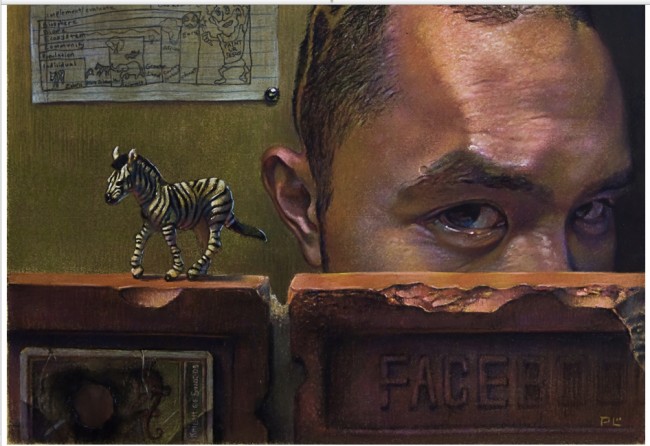by Fran Watson
The Carnegie, April 4 – May 17, 2014
The magnet piece in Recognized: Contemporary Portraiture at the Carnegie Arts Center was definitely “Biker Mice”. With the same fury seen in Jean-Michel Basquiat’s art, Marci Rosin splashed her signature subject based on the cartoon, “Biker Mice from Mars” with graffiti and speed. I tried to escape, but was drawn back to the two outrageous supermice in all their active glory. Rosin apparently has adopted the aggressive rodents, as her own and has made them the subject of many works in the past few years. In keeping with definitions of portrait, this very personal subject expressed the artist more clearly than any dozen of traditional head and shoulders pieces.
Happily, head and shoulders were stretched to include or exclude more or less all through the exhibit. A pastel portrait, rife with amazing detail, by Paul Loehle showed only the top half of a head, but the surrounding objects obviously contained stories and events important to him. Without a key, we will never know what importance a toy zebra, a torn paper full of sketches and notes pinned to the wall featuring a cartoon figure clad in a t-shirt imprinted with “Know UR Jesus”, or the two bricks behind which the remainder of the subject crouches, one of which is incised with “FACEBOOK”.
When I spoke of detail, this is truly the first portrait I have seen with the actual drops of perspiration on the subject’s forehead. The skin on which they rested was rendered with such perfection it was rather uncanny. Another pastel portrait by Loehle, ”Aftermath”, exhibited similar miraculous detail, again embellished with personal images . A large, bearded head once again pushed realism into something far more than Rembrandt could have comprehended. This lushly hirsute individual stared out from hypnotic blue eyes, echoed in the blue eggs resting in a bird’s nest in his beard. On his shoulder the parent of the eggs seems to be whispering in the man’s ear. I felt the need of a gallery psychologist.
”Wooden Man”, fiberglass and acrylic, by Jonathan Hand intrigued differently. Harshly carved pieces stood out from a dark base shaped like a portion of tree trunk. Its strength was almost perceptible, its demeanor placed it coldly apart from other portraits, as did the two charcoal portraits by Mark Hanavan. A man and a woman are encased in obviously previously used glass cabinets, shutting them off from each other and all else. Entitled “Knowing”, these two large charcoal drawings clearly portrayed their theme, that of anonymous people who are cut off from real life by too much technology. Their expressions show no emotion, no cognizance, no connection, lacks all too often witnessed in people everywhere deeply involved with their smart phones.
From tidy graphite drawings of nude models by Jason Franz to a wall of hands painted by Jessie Boone, extreme realism took many forms. Boone’s grouping of small hand paintings evoked personalities with far more impact than her standard portraits, while Franz’s 90 minute pieces from 2008 through 2011 were an indication of his ongoing interest in drawing the nude. Crisp and correct, they were hung in a group next to Kevin Muente’s excellent realistic painting of a young woman standing with her bicycle against a background full of sky and a rainbow. One or the other would have fared much better alone. Unfortunately, much of the exhibit seemed unrelated to its fellows and occasionally to the theme of the show itself. Artists on the second floor , were sometimes diminished by the vacillating quality of their own work.
Curator Matt Distel used a wide brush to select his artists. Alison Shephard’s display in the Duveneck Gallery, using stylized, beautifully rendered paintings of “Adam and Eve” was into dialogue from start to finish. The description of “portrait” was somewhat obscured by the highly colorful narrative nature of the complete room. While the 3D prototypes, shiny white duplicates lined up on wall shelves on the first floor and grouped nearby, by Katie Parker and Guy Michael Davis qualified as sculpture, they’re only originality lay in the decoration on each of the four copies of Hiram Power’s sculpted bust of Alphonso Taft and on the five of Lenin. I had seen the Taft pieces at the Taft Museum of Art when they first appeared in 2012, and wondered about their qualifications then. Perhaps the very reproduction was the art, leaving their purpose to the imagination.
In reviewing the gallery guide available at the desk, I noted Matt Distel’s statement on “Recognized”. “Portraiture is a genre that is often associated with traditional art making. This exhibition aims to simultaneously maintain and challenge the perception of that association. Portraiture….. can support traditional techniques and approaches and also embrace new methods and imagery”. Great sentiment, but I missed the evenness of careful curation and a larger inclusion of “new methods and imagery”.






April 30th, 2014at 2:33 pm(#)
I fully enjoyed this exhibition. It is rare that such a large show maintains quality throughout, but that is the power of the curator and the artists involved. I have visited 3 times in 3 weeks.
Katie Parker and Guy Davis series of ceramic art is a interesting direction and highly successful.
It is nice seeing such a strong show in Covington /Carnegie.
Looking forward to the next presentation.